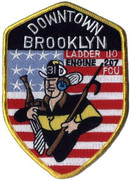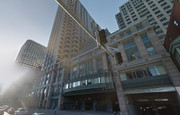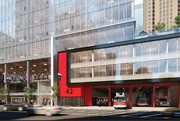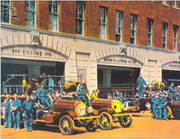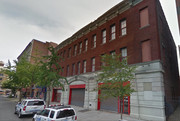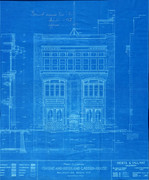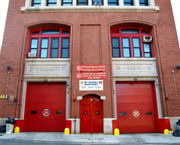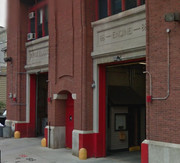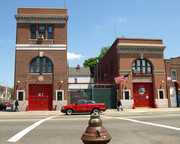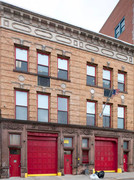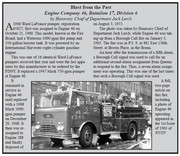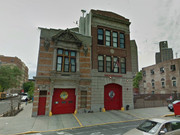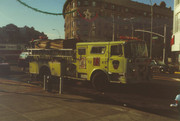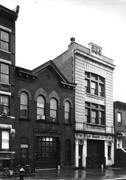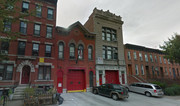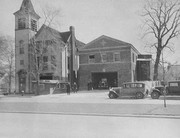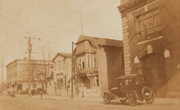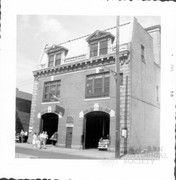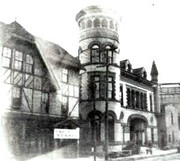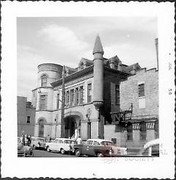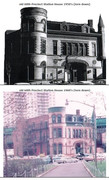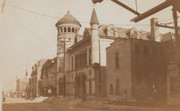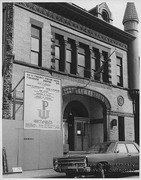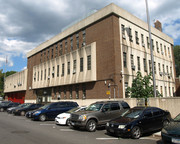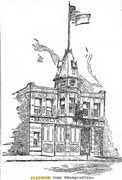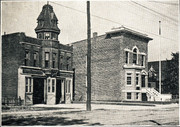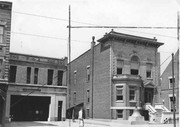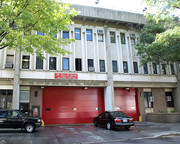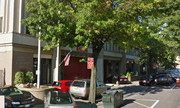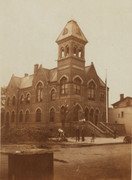Ladder 110 Firehouses 172 Tillary Street Fort Greene, Brooklyn Battalion 31, Division 11
Ladder 10 Brooklyn Fire Department organized 264 State Street 1891
Ladder 10 Brooklyn Fire Department became Ladder 10 FDNY 1898
Ladder 10 became Ladder 60 1899
Ladder 60 became Ladder 110 1913
Ladder 110 moved 365 Jay Street former at Engine 207 1946
Ladder 110 moved 172 Tillary Street at Engine 110 1972
Ladder 10 BFD 245 Pearl Street:
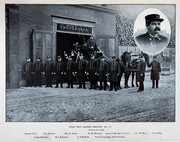
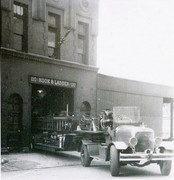

Ladder 110 365 Jay Street with Engine 207/Battalion 31:
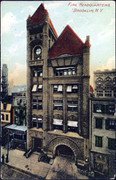
Notes - former BFD Headquarters; former quarters of Ladder 68(118)/Water Tower 6/Searchlight Engine 3/Rescue 2/Division 10; Ladder 110 shared quarters with Engine 207/Battalion 31 1949-1972
https://www.revolvy.com/main/index.php?s=Old%20Brooklyn%20Fire%20Headquarters
http://www.brownstoner.com/architecture/building-of-the-day-365-jay-street/
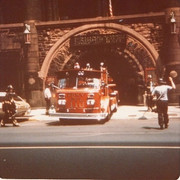
Engine 207/Ladder 110/Super Pumper (disbanded)/Super Tender (disbanded)/Satellite 6/Field Comm Unit (relocated)/MERV/Battalion 31/Division 11/Brooklyn Boro Command firehouse 172 Tillary Street:

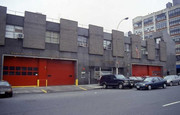
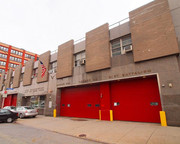
2nd Alarm - roof fire - April 30, 1906 - 172 Tillary Street firehouse:
http://www.firstduephotos.com/Fire-Service-Photography/Fireground-Photographs/FDNY-2-Alarms-on-Tillary-St/i-BhCSG3n
Ladder 110:
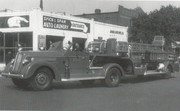


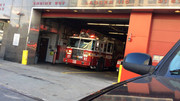
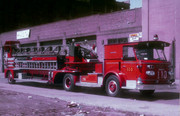

Videos:
https://www.youtube.com/watch?v=bG_VlwS3MiQ
https://www.youtube.com/watch?v=OMSgxg9t_0M
https://www.youtube.com/watch?v=iZcZBCduj7I
Ladder 110 FDNY Medals:
CARL A. MONTELIN FF. LAD. 110 FEB. 27, 1908 1908 1909 HURLEY

JAMES J. C. B STEUER FF. LAD. 110 MAR. 15, 1942 1942 CRIMMINS
FRANCIS J. B RYNIKER FF. LAD. 110 MAR. 15, 1942 1942 1943 JOHNSTON
FRANCIS P. V. B O'BRIEN FF. LAD. 110 DEC. 24, 1950 1950 1951 DOUGHERTY
PETER J. M EISEMANN FF. LAD. 110 NOV. 11, 1957 1957 1958 JOHNSTON
THOMAS R. B JONES FF. LAD. 110 DEC. 12, 1961 1961 1962 FDR
ANTHONY L. B MOTTI LT. LAD. 110 JUL. 22, 1971 1971 1972 STIEFEL
DONALD H. B MISCHKE FF. LAD. 110 FEB. 10, 1973 1973 1974 JOHNSTON
JOSEPH P. B FLYNN LT. LAD. 110 JUN. 12, 1978 1978 1979 FDR
THOMAS J. B AZEVEDO FF. LAD. 110 APR. 21, 1988 1988 1989 LA GUARDIA
KEVIN C. B KANE FF. LAD. 110 SEP. 12, 1991 1991 1992 BROOKLYN CITIZENS
Ladder 110 LODDs:
FF John Carey, Ladder 110, died from injuries from collision with Engine 226 responding on 2nd alarm for box 33-155 on September 28, 1907

FF Frank A. Maher, Ladder 110, died from injuries from accident responding to alarm for fire April 29, 1909

FF Kevin C. Kane, Ladder 110, died due to roof collapse at fire in E. New York when Ladder 110 was relocated to Ladder 103 September 13, 1991
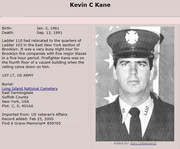
Lt Paul Mitchell, Ladder 110, World Trade Center, September 11, 2001

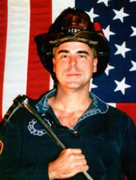
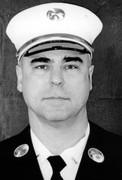
http://www.silive.com/september-11/index.ssf/2010/09/paul_mitchell_46_fire_lieutena.html
RIP - Never forget.
Ladder 10 BFD Early History:
"HOOK AND LADDER COMPANY NO. 10 - A BUSY FIRST YEAR.
It was on Aug., 1, 1891, that Commissioner ENNIS declared Hook and Ladder Company No. 10 duly organized and ready for active service. Located in a district bounded by Johnston Street, Nevins Street, First Place and Smith Street, and on the west by the water-front, the company has a vast amount of the most valuable property in the city under its protection. It responds to calls from 117 boxes on a second-alarm, the remotest box being at the end of Red Hook Point. The company is quartered in a model two-story structure on State Street, near Boreum Place. The cellar of the house has been fitted up as a gymnasium and among the appliances for developing the muscles of the men are rowing-machines, Indian clubs, dumb bells, heavy and light hammers and quoits. The house is furnished with the latest improved second-class Hayes truck, and three of the handsomest and quickest working horses in the Department. "Larry," "Billy" and Dick" are their names, and their colors are black, dark-brown and dapple bay. They can get out of the house with ease in twelve seconds. " Billy," who is nearly seventeen hands high and weighs over 1400 pounds, prior to coming to Truck No. 10 served five years with Truck No. 2. and he is so well-versed in the telegraph alarm system that no amount of persuasion will induce him to leave his stall on a " test-call." Two days after the organization of the company another member was added to the roster, whose name does not appear on the pay-rolls at Fire Headquarters. He was diminutive in size when he first entered the door of the truck-house and he wore a fur coat which in color resembled a tortoise shell. He carried no "grip," but his general demeanor indicated as he settled himself in a chair, that he had come to stay; and stay he did, for every man in the company took the young stranger by the paw, christened him " Patsey," and adorned him with a silver collar. Good warm milk and an occasional piece of meat developed " Patsey " into a full-fledged fire cat. In the gymnasium he took lessons in "high vaulting" and " running jumps," at which he has become an expert. His favorite place of sleeping was on the men's coats on the extreme end of the extension ladder. One day as he was taking an afternoon nap, an alarm sounded from Box 58, corner Hoyt and Warren Streets. As a rule "Patsey" was on the alert at the first sound of the gong, but on this particular occasion he was not aroused from his slumbers until the truck was on the way to the fire. At Dean and Pacific Streets, Fireman Collins discovered "Patsey" with his nails buried deep into one of the coats and to all appearances enjoying the situation. When the truck arrived at the fire "Patsey " was transferred to the driver's seat and covered up with a coat, from which position he seemed to enjoy the excitement. The men who make up the company are intelligent, temperate, conscientious and brave, and since they have been banded together under the same roof have experienced all the hardships and perils incident to the life of a fireman.
Foreman JAMES FRANCIS MURRAY has been in many perilous positions, and though his name is not on the roll of " life-savers," it is not because he stood back when human life was in peril. He was born in Brooklyn, July 12, 1851. He was appointed a fireman Sept. I, 1878, and assigned to Engine No. 4. While with this company, on Oct. 22, 1881, he was promoted to the grade of Foreman. In Feb., 1890, he was transferred to Engine No. 10, and on Aug. 1, 1892, was transferred to the company which he now commands. At the glass house fire in State Street, he had his foot severely injured, and at the Wallabout Market fire in the summer of 1890, he was overcome by heat and smoke for a time.
Assistant Foreman THOMAS STEVEN COPPINGER is a native of Brooklyn, born Nov. 23, i86o. He was appointed to the Department March 17, 1888, and was assigned to Engine No. 4 and afterward transferred to Engine No. 26. While in the latter company, on June 1, 1891, he was promoted to be Assistant Foreman and sent to Engine No. 1, from which he was transferred to the present one. On March 2, 1890, while a member of Engine No. 26, he assisted Foreman DOOLEY in rescuing a woman from the third story of No. 362 Atlantic Avenue. On Aug. 31,1890. at a fire in the tenements Nos. 452 and 452 1/2 Atlantic Avenue, Mr. COPPINGER found in a dark bedroom on the third floor of No. 452, a three-year-old child named Charles SCHMIDT, who, but for his prompt arrival, would have perished. The heat was intense and the smoke stifling, but the brave young fireman fought his way through it with the child in his arms and reached the street in safety.
ANTHONY A. COOKE, the driver, beams with good-nature. Since he was able to toddle about in short clothes he has been around horses, and as he grew to manhood his love for them increased. As a driver there is none better in the Department, and he is happiest when he sits behind handsome " Billy " and his mates and gives them their heads for a long run. Mr. COOKE was born on Hamilton Avenue, May 25. 1856. He donned a fireman's uniform on Feb. 18, 1887, and since that time has been the driver of Engines Nos. 3 and 26, and Trucks Nos. 1, 5 and 10. At a fire at No. 359 Fulton Street he stood on the roof and held the rope which saved the lives of David and Sarah GOODMAN, who were tenants of the fourth floor, and had been cut off from all other means of escape.
LESTER AUGUSTUS ROBERTS has a fresh, clear complexion, kindly blue eyes and a most amiable disposition. He is tall, broad-chested, strong-limbed, and a perfect athlete in muscular development. He is of a literary turn of mind, and during his thirty years of life has been around the world. He was born in Brooklyn. March 10, 1862, and served in the United States Navy from April 3, 1878, to March 10. 1883 and was an apprentice on board the U. S. S. "Alliance" when that vessel made her famous voyage to the Arctic regions in search of the lost steamer " Jeannette." Mr. ROBERTS is as brave as he is good-looking and intelligent. He was made a fireman April 1, 1885, and assigned to Truck No. 1. While with this company in July, 1885, he saved the lives of John and Ellen MCGRATH at a fire, corner of Hicks Street and Hamilton Avenue. On the night of Aug. 31, 1890, at No. 452 Atlantic Avenue, he took a very active part in the rescue of several persons. On Feb. 22, 1892 at No. 395 Fulton Street, Mr. ROBERTS, then a member of Truck No. 10, assisted in getting Jacob MICHAELSON and Mrs. GOODMAN out, and caught the latter's baby, which had been thrown by the frantic mother from the fourth story window.
JOSEPH BARRETT was born in Ireland, Aug. 6,1866, and became a fireman March 21, 1888. He has since done duty with Engines Nos. 3 and 26 and Trucks Nos. 1 and 10. Aug. 31, 1890, he found Mrs. DORSHEIMER and her son on the third floor of the burning building. No. 422 Atlantic Avenue, and carried them to the roof of the adjoining building. He also assisted in the rescue of Jacob MICHAELSON and Mrs. GOODMAN at No. 359 Fulton Street, Feb. 22, 1891.
JOHN MICHAEL RYAN is a native of Brooklyn, and was born July 7, 1864. He was made a fireman June 12. 1889, and at the fire. No. 359 Fulton Street, in Feb.. 1891. assisted in saving Samuel Goodman and his wife. On Jan. 9. 1892, as he was passing No. 98 Union Street, he heard the cry of " Fire," and running quickly to the third story found Josephine RICOLO, eighty-four years old, enveloped in flames, caused by the explosion of a kerosene oil stove. He smothered the flames with his heavy overcoat and carried the woman down to the basement and summoned an ambulance.
HENRY W. MALONEY was born in Brooklyn. Jan. 7, 1864, and on June 15, 1885, became a member of the Fire Department. He was attached to Truck No. 5 on Aug. 31, 1890, and assisted in rescuing James DONNELLY his wife, sister-in-law and two children from the top floor of No. 452 1/2 Atlantic Avenue. On Dec. 22, 1891. at No. 344-46 Smith Street, at great personal risk he worked his way up to the third floor of one of the houses, where he found Louisa and Alice MOTTERAN, and carried them down the fire-escape to a place of safety.
WILLIAM E. COLLINS was born April 19, 1867, in Brooklyn, and his appointment to the uniformed force dates from Aug. 11. 1891. Although young in the business he has a record for saving the life of a woman at No. 117 Atlantic Avenue, on Dec. 24, 1891.
JOHN KELLY was born in Brooklyn, Oct. 5, 1867, and became a fireman Oct. 29. 1890. On arriving at a fire at No. 38 Atlantic Avenue. Sept. 27, 1891, he was told that a boy named Edmund RALPH was asleep in a dark bedroom on the first floor. It was impossible to reach the boy by the stairway, so Kelly climbed the fire-escape at the rear of the house, and after groping about in the dense smoke succeeded in reaching the lad, who was by this time nearly suffocated, and carried him out to the street.
EDWARD FINN, also a native of Brooklyn, was born Aug. 9, 1836, and after serving some years in the United States Navy, joined the uniformed force at its organization, Sept. 15. 1869. He has been an active worker at all the big fires since that time. and fortunately escaped without injury.
WILLIAM FRANCIS Down was born Sept. 4, 1862, in Brooklyn, and since he became a fireman. Dec. 3, 1888, has served the Department faithfully and well.
PATRICK JOSEPH SULLIVAN was born in King's County, Nov. 27. 1865, and after passing the civil service examination with a good percentage, was duly appointed a member of the uniformed force, Oct. 29, 1890.
JOHN PADIAN is a native of England, and first saw the light in St. Helens, Lancashire County, on July 13, 1861. He was made a fireman March 31, 1892, and although young in his career, has the mettle in him to make an efficient member of the force. While the company has been in existence the men have had a great number of fires which required many hours of hard labor to subdue. Among them were the chemical works at ,the foot of Jay Street; Baum's building, comer Myrtle Avenue and Bridge Street; Pinto's stores. Red Hook Point; Smith & Gray's clothing house, and the sash and blind factory fire at Fulton and State Streets. On the first day of the water famine in Brooklyn they were summoned to a fire, comer of Court and Butler streets, and on their return from that fire they were called out again to a fire at Carroll and Court Streets.
- from "OUR FIREMEN : THE OFFICIAL HISTORY OF THE BROOKLYN FIRE DEPARTMENT"
Ft. Greene Neighborhood:
https://en.wikipedia.org/wiki/Fort_Greene,_Brooklyn

